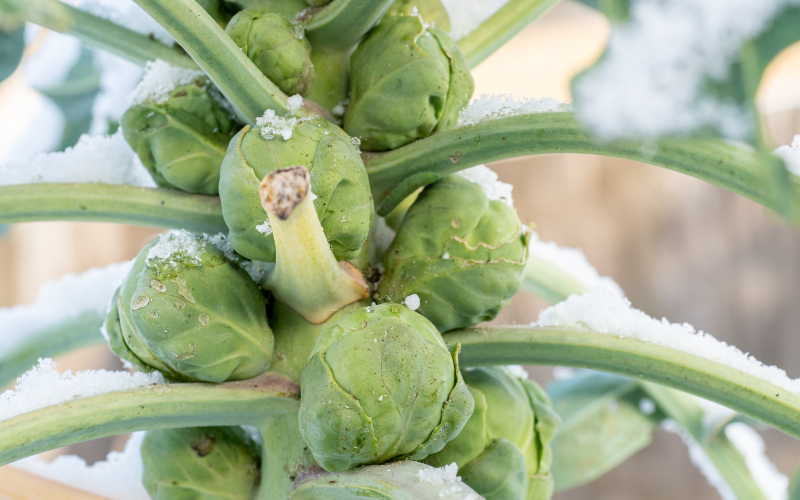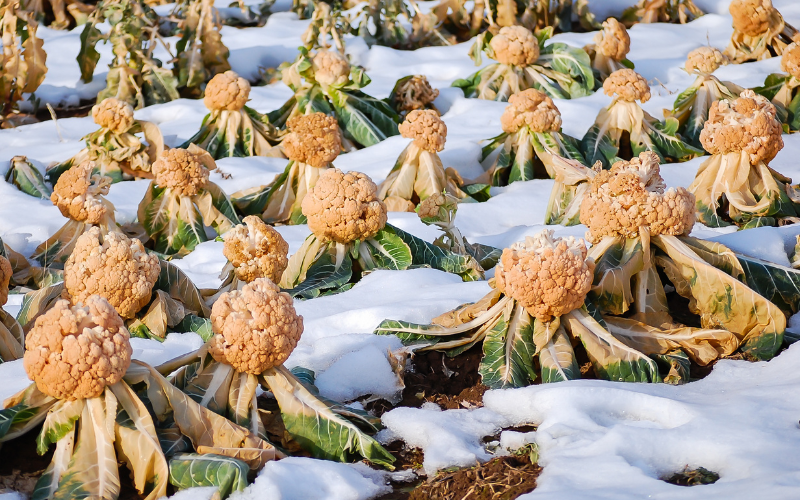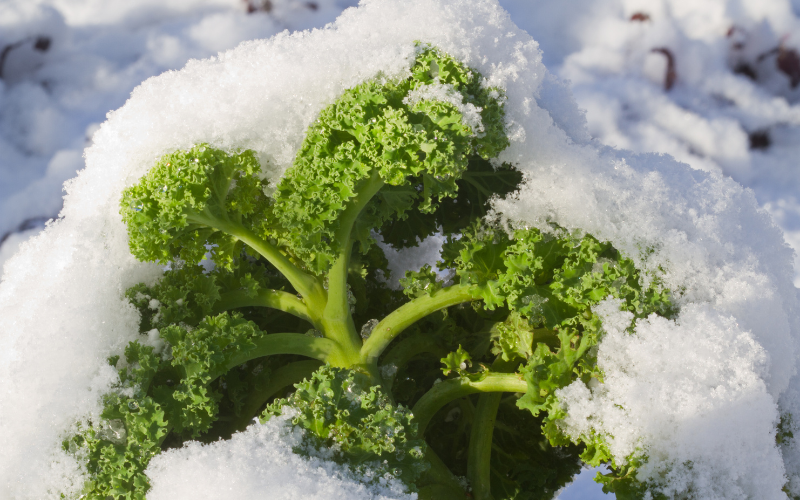Brassica vegetables, also known as cole crops, typically thrive in temperatures ranging from 15°C to 20°C. They produce the best quality when they mature in consistently cool to moderate temperatures, making them ideal additions to your cool-season garden.
The cold tolerance of brassica vegetables varies significantly, with the stage of plant growth significantly affecting this resilience. Young plants exhibit greater resilience to both low and high temperatures than mature ones. In properly acclimated conditions, most plants can endure some frost, and some can even withstand freezing temperatures.
1. Kale

Kale has remarkable cold resistance and can endure frost and freezing temperatures with little to no visible harm. Interestingly, kale often develops a sweeter and more flavorful taste as it faces colder weather.
Kale’s leaves possess a natural frost defense mechanism. As the temperature drops, the plant converts some of its starches into sugars, functioning as natural antifreeze. This process not only protects the plant’s cells from freezing damage but also enhances the sweetness of the leaves.
Kale shines as an ideal choice for winter gardening, particularly in regions with mild winters. In such areas, kale offers a continuous harvest throughout the autumn and winter seasons. In colder climates, it exhibits remarkable resilience, surviving beneath a blanket of snow and remaining ready for harvest when needed.
Although kale boasts impressive cold-hardiness, providing protection during exceptionally harsh winter conditions is advisable. A noteworthy feature of kale is its versatility; you can selectively harvest the outer leaves as needed, allowing the inner leaves to continue growing. This trait makes it particularly suitable for smaller gardens or for individuals seeking a consistent supply of fresh greens during the cold season.
2. Brussels Sprouts

Brussels sprouts are highly cold-resistant and often taste better after exposure to frost. Thriving in cool to cold temperatures, they can withstand lower temperatures exceptionally well, enduring light frosts and even more severe cold spells without significant damage.
Similar to kale, Brussels sprouts also has the ability to taste sweeter and develop a richer flavor after exposure to frost. Frost triggers the conversion of starches into sugars, resulting in a sweeter taste. Therefore, the optimal time to harvest Brussels sprouts is after a light frost but before extremely cold weather sets in, ensuring the highest quality and taste.
Brussels sprouts are typically grown as a late-season crop. They are often planted in early to mid-summer for a fall harvest or even in late summer for a winter harvest in regions with mild winters. In some cases, they are grown for overwintering and harvested in early spring.
Despite their high cold tolerance, providing protection during extreme cold snaps can be beneficial. Row covers or cold frames can effectively shield the plants from the harshest winter conditions.
3. Collard Greens

Collard greens exhibit exceptional cold resistance, making them a favored choice for late-season and winter gardens. Thriving in cool to cold temperatures, they can endure frost and even more severe cold snaps without significant damage.
Typically grown as a late-season crop, collard greens are often planted in early to mid-summer for a fall harvest. In regions with mild winters, they can be overwintered, allowing for harvesting in late winter or early spring.
Harvesting collard greens when their leaves are young and tender is crucial for the best flavor. Similar to kale and Brussels sprouts, their leaves become sweeter and more tender after exposure to frost, as cold weather prompts the conversion of starches into sugars. This makes the period after a light frost but before extremely cold weather sets in the best time to harvest collard greens.
While collard greens are highly cold-tolerant, providing protection during severe cold spells is advantageous. Row covers or cold frames can be used to shield the plants from extremely harsh winter conditions, effectively extending the growing season.
4. Broccoli

Broccoli exhibits moderate cold resistance and can endure light frosts. Remarkably, it often tastes better after exposure to frost. Certain broccoli varieties even become sweeter and more flavorful when subjected to colder temperatures, thanks to a natural defense mechanism where the plant converts starches into sugars to protect itself from freezing.
Broccoli is typically planted in late summer or early fall for a fall harvest. It can also be planted in early spring for a spring harvest. Although broccoli is cold-resistant, providing some protection during harsh cold spells can help maintain its quality.
5. Cauliflower

Cauliflower, while moderately cold-resistant, can endure light frosts without significant damage. However, prolonged exposure to severe frost or freezing temperatures can harm the developing curd, the edible part of the plant.
Cauliflower is typically grown as a fall crop or started indoors in late winter or early spring for a spring harvest. In regions with mild winters, it can be overwintered for early spring harvesting. Harvesting cauliflower heads promptly, especially before the onset of extreme cold, is essential for the best quality and flavor.
Providing protection from cold weather can help maintain cauliflower quality. Cold frames or frost blankets are effective tools for shielding these plants from extreme cold conditions.
6. Cabbage

Cabbage is a cool-season vegetable with moderate cold tolerance. It can withstand cooler temperatures better than many warm-season crops but has limitations regarding how much cold it can endure.
Moderately cold-resistant, cabbage can endure light frosts and cool weather without significant damage. However, it’s not as cold-hardy as some other brassica vegetables, like kale or Brussels sprouts. Frost can damage the outer leaves, but the inner head may remain unharmed. In milder winter climates, you can often continue harvesting cabbage throughout the winter.
Providing protection from cold weather can help maintain cabbage quality. Row covers or cold frames can effectively shield the plants from damage. Cabbage is typically planted in early spring for a late spring to early summer harvest or in late summer for a fall harvest. In regions with mild winters, it can also be overwintered for early spring harvesting. Harvesting cabbage heads promptly, especially before the onset of extreme cold, is crucial for the best quality and flavor.
7. Kohlrabi

Kohlrabi, known for its unique appearance and crisp, mild flavor, displays a reasonable level of cold tolerance. It can withstand light frosts and cool weather without significant damage to the plant.
Typically planted in early spring for a late spring to early summer harvest or in late summer for a fall harvest, kohlrabi is harvested for its swollen stem while it’s still tender, typically when it reaches the size of a golf ball to a tennis ball.
Frost can damage the leaves and outer skin, but the inner flesh may remain intact. Row covers or cold frames can provide insulation and shield the plants from severely cold conditions.
As you would have noticed, brassica vegetables offer a diverse array of options for cool-season gardening. Their levels of cold tolerance vary, with kale, collard greens, and Brussels sprouts exhibiting exceptional resilience to frost and freezing temperatures, while cauliflower, broccoli, cabbage, and kohlrabi have less cold tolerance and are suited for growing in the cool season but with some restrictions.
Understanding the differences in the cold tolerance of these vegetables is essential for successful cool-season gardening, allowing for a continuous supply of fresh and flavorful produce, even in cooler months.

